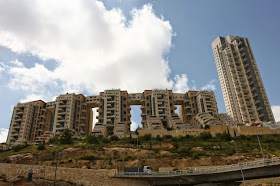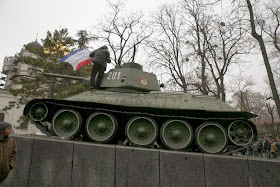by Benson Agoha
Salvage Works on the Southern pier of the Woolwich Ferry is nearing completion after six months during which a section of the pedestrian route remained closed.
The works are being carried out by Concrete Repairs Limited (CRL), in partnership with Briggs (operators of the Woolwich Ferry), and Transport For London (TfL).
CRL uses a technique known as hidro-demolition to remove damaged parts by flushing out grit and rust before repairs are carried out.
They are named after eminent politicians who have contributed to the well-being of Woolwich in some way or the other. But since 1963, the ongoing restoration works is the first of its kind.
Mr. Patrick Smyth, the Site Manager of CRL tells me that the job involves a technique called 'hydro-demolition' and that restoration covers about 65 Colunms of both concrete abutment and piers, some of which have their footings deep underwater. On the average each column is about 10 metres (some 33 feet) long.
High pressure pumps are used to remove corrosion and cracks - up to where reinforcing steels are exposed.
"Over the years," he says, "some of these concrete columns supporting the pier have developed cracks just as some parts of the steel core have corroded, and needed repairs. This is done using high pressure water pumps to blast off weak concrete, before a new one, made from natural cement, and which are environment friendly, are resprayed."
Shane More (with me in photo), one of the site workmen tells me that the River experiences two tides daily and as a result, the works are planned to fit in - taking advantage of low tide.
The site Manager concur. "Tide is one of the reason's why the initial assessment missed some of the cracks," he says. Additionally, he tells me that the southern end of the approach in Woolwich is deeper than the North Woolwich end, and therefore involved more work.
And what is the scale of the job in terms of the number of concrete columns. Shane tells me they work on 65 columns spread along the semi-arc approach, and the job is done systematically in other that neither structure nor traffic above is disturbed.
Mr. Smyth shed more light, pointing my attention to a archy-drawing hanging on the wall, which shows sketches of the work plan. He says, because the ferry has to remain in operation, jobs are selected and distributed in a half-harzard or zig-zag manner and in sets that ensure an even distribution of weight at all times.
The fact that fast hardening cement is used means it dries up as it hits the target portions. And even if water touches it shortly thereafter, it will not be damaged.
As pointed out above, the average height of each column on the southern side, according to Site Manager is 10 meters ( some 33 feet).
With the works at the Southern end almost complete, the team is getting ready to head north from early May, and may be on site as early as 7th, after a confirmation meeting with TFL Bosses.
Mr. Smyth is optimistic that with what they know now about the scale of job involved, things will likely be faster and reckons they will be done with whole job by August, 2014.
TFL is spending about £30m on the Ferry Approach restoration, river-side repairs and a group of other jobs around Woolwich.
* Twitter: @woolwichonline.
* Photo Credit: Courtesy of Shane Moore.
* Our Thanks to Mr. David Newcomb, Operations Manager (Briggs); Mr. Patrick Smyth, Site Manager (CRL); Mr. Shane More, Site workman; as well as Onboard Crew of the Woolwich Ferry, for their time and assistance.
Salvage Works on the Southern pier of the Woolwich Ferry is nearing completion after six months during which a section of the pedestrian route remained closed.
The works are being carried out by Concrete Repairs Limited (CRL), in partnership with Briggs (operators of the Woolwich Ferry), and Transport For London (TfL).
CRL uses a technique known as hidro-demolition to remove damaged parts by flushing out grit and rust before repairs are carried out.
* With Shane Moore at Site.
Although the history of the Woolwich Ferry dates back to 1884, when the metropolitan board of works obtained statutory authority
to ferry across the Thames at Woolwich, Passengers, animals,
vehicles and goods, free of all tolls, rates or charges, and commissioned on March 23rd 1889 by the then Chairman of the London County Council, Lord
Roseberry, it was in 1963 that three
diesel engined ferry boats were constructed and our report is relevant from that time.
The New Woolwich Ferry approach Pier was constructed to service the boats built by the Caleden Shipbuilding and Engineering Company, Dundee, which were put in use for a total cost of £804,000. Each was licensed to carry 500 passengers
and 200 tons of vehicles.
They are named after eminent politicians who have contributed to the well-being of Woolwich in some way or the other. But since 1963, the ongoing restoration works is the first of its kind.
Mr. Patrick Smyth, the Site Manager of CRL tells me that the job involves a technique called 'hydro-demolition' and that restoration covers about 65 Colunms of both concrete abutment and piers, some of which have their footings deep underwater. On the average each column is about 10 metres (some 33 feet) long.
High pressure pumps are used to remove corrosion and cracks - up to where reinforcing steels are exposed.
"Over the years," he says, "some of these concrete columns supporting the pier have developed cracks just as some parts of the steel core have corroded, and needed repairs. This is done using high pressure water pumps to blast off weak concrete, before a new one, made from natural cement, and which are environment friendly, are resprayed."
I asked, why 'environment friendly'? Mr. Smyth tells me that the cements are made with natural compounds that will not harm the environment and that equally importantly, it has to harden before water touches it. So it is also fast setting or hardening.
Have they faced any glitches so far? "Well", he says "there are issues that arose, that were not obvious from the initial assessment, because they were done by accessors from a boat and, because of time of assessment, were missed. When they were discovered a review and addition consent from TFL, became necessary, adding to the duration."
Have they faced any glitches so far? "Well", he says "there are issues that arose, that were not obvious from the initial assessment, because they were done by accessors from a boat and, because of time of assessment, were missed. When they were discovered a review and addition consent from TFL, became necessary, adding to the duration."
Shane More (with me in photo), one of the site workmen tells me that the River experiences two tides daily and as a result, the works are planned to fit in - taking advantage of low tide.
The site Manager concur. "Tide is one of the reason's why the initial assessment missed some of the cracks," he says. Additionally, he tells me that the southern end of the approach in Woolwich is deeper than the North Woolwich end, and therefore involved more work.
And what is the scale of the job in terms of the number of concrete columns. Shane tells me they work on 65 columns spread along the semi-arc approach, and the job is done systematically in other that neither structure nor traffic above is disturbed.
Mr. Smyth shed more light, pointing my attention to a archy-drawing hanging on the wall, which shows sketches of the work plan. He says, because the ferry has to remain in operation, jobs are selected and distributed in a half-harzard or zig-zag manner and in sets that ensure an even distribution of weight at all times.
The fact that fast hardening cement is used means it dries up as it hits the target portions. And even if water touches it shortly thereafter, it will not be damaged.
As pointed out above, the average height of each column on the southern side, according to Site Manager is 10 meters ( some 33 feet).
With the works at the Southern end almost complete, the team is getting ready to head north from early May, and may be on site as early as 7th, after a confirmation meeting with TFL Bosses.
Mr. Smyth is optimistic that with what they know now about the scale of job involved, things will likely be faster and reckons they will be done with whole job by August, 2014.
TFL is spending about £30m on the Ferry Approach restoration, river-side repairs and a group of other jobs around Woolwich.
* Twitter: @woolwichonline.
* Photo Credit: Courtesy of Shane Moore.
----------<><><>-----------
* Our Thanks to Mr. David Newcomb, Operations Manager (Briggs); Mr. Patrick Smyth, Site Manager (CRL); Mr. Shane More, Site workman; as well as Onboard Crew of the Woolwich Ferry, for their time and assistance.
















































































































































































No comments:
Post a Comment